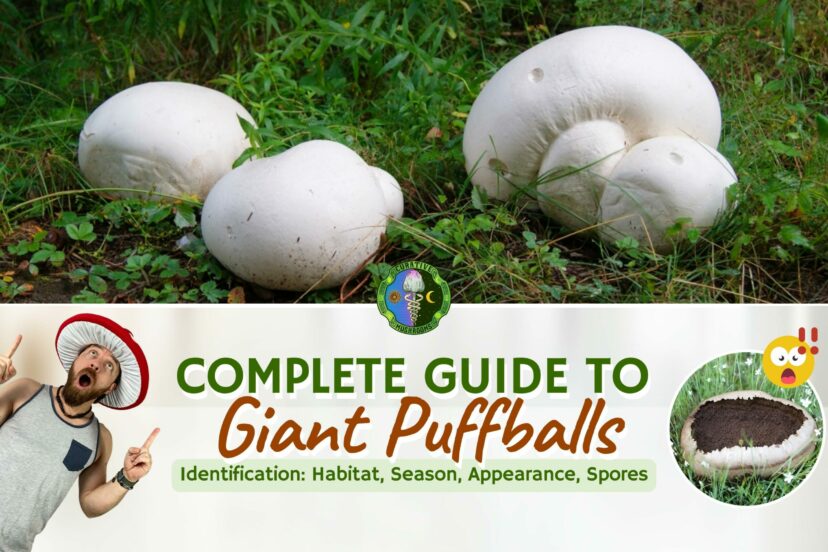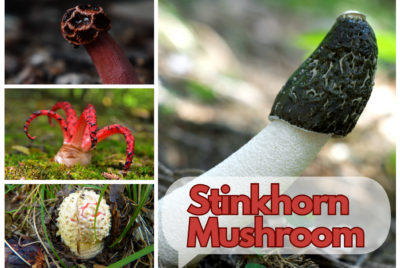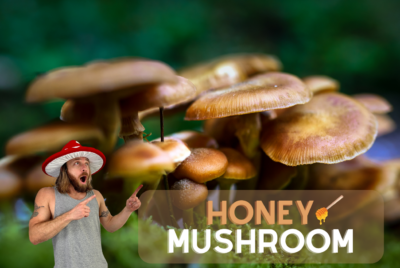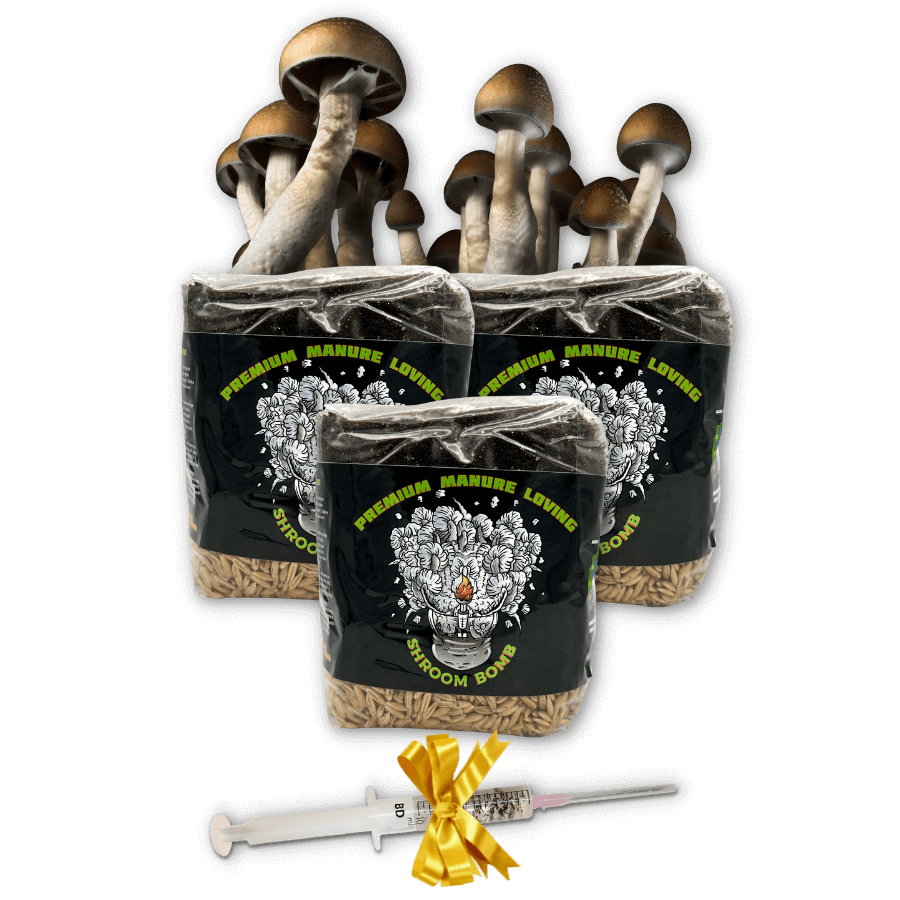Mushroom enthusiasts and foragers are often captivated by the diverse and mysterious world of fungi. Among…
Calvatia Gigantea or Giant Puffball Mushrooms Identification

Calvatia gigantea, commonly known as Giant Puffball has gained popularity online since the pandemic. This “strange” fungus is currently trending on TikTok in thousands of identification, hunting, and culinary videos!
For inexperienced foragers, a mature Giant Puffball is probably the safest mushroom to hunt. It bears only a passing resemblance to a football when spotted from a distance.
While these mushrooms can be found all over the world and make for a great meal, it’s important to know how to identify one accurately.
Complete Guide to Giant Puffball (Calvatia Gigantea) Mushroom Identification
In this Giant Puffball Mushroom Identification blog post, we’ll be taking a deep dive into everything you need to know about C. gigantea. By the end of this post, you should feel confident enough to spot a Puffball mushroom with ease!
1. What are Puffball Mushrooms?

Puffballs are not a single species, but rather a group of mushrooms from several genera such as Apioperdon, Bovista, Calvatia, and Lycoperdon. They are saprobic fungi. Which means they do not parasitize other species. Instead, they decompose dead organic matter, such as decomposing leaves, to grow.
All Puffball mushrooms are cased within a one- or two-layered skin that has the shape of a ball. Their interior when they are young is white and firm. But as they ripen and dry, they become a mass of brown, powdery spores. Thus, true Puffballs are edible only when picked young.
The Giant Puffball Mushroom derived its name from looking like a huge ball that puffs a spore cloud

1.1. Etymology
Its scientific name Calvatia gigantea derives from the Latin word calvus meaning “bald,” and gigantea meaning “like that of the giants.”
1.2. Other Names
Calvatia gigantea was previously or less commonly referred to as Lycoperdon giganteum, Globaria gigantea, Lasiosphaera gigantea, Langermannia gigantea, and Bovista gigantea.
1.3. Taxonomic History
Puffballs—including Common Puffballs, Earthstars, Earthballs, Eyeballs, Stalked Puffballs—Stinkhorns, and Birds nests fungi previously belonged to the now outdated and polyphyletic class Gasteromycetes.
Polyphyletic describes taxonomic groups that have similar character states that descend from one or more ancestral lineages. Most taxonomists reject the use of this taxa.
Gasteromycetes translates to “stomach fungi.” Which means they produce their spores inside a spherical fruiting body that an outer skin initially encloses.

According to the Dictionary of Fungi (1995), Gasteromycetes was already declared invalid. It is not currently acceptable to keep it in a natural classification due to its polyphyletic nature. Now, Giant Puffball Mushrooms belong to the division Basidiomycota.
Basidiomycota is a large group of fungi with over 30,000 species. They include many familiar mushrooms—bracket fungi, Puffballs, earth balls, earth stars, stinkhorns, false truffles, and jelly fungi.
The Native Americans like the Lakota tribe were familiar with Puffballs. They are used as medicine, food, and ornament. Some tribes would wrap dried ones around their necks to help ward off ghosts and bad spirits.
2. Where and When Do Giant Puffballs Grow?

2.1. Location and Habitat
Giant Puffball mushrooms are found throughout North America, Europe, and Asia, often at high elevations (3,000 to 11,000 feet). They grow in open areas such as meadows, fields or grasslands, and woods, often near deciduous trees.
The mushrooms can also be found in areas that have been disturbed by humans. Such as parks, gardens, logging roads, and construction sites.
They can grow individually or in a small circular group—a fairy ring. According to folklore, mushroom fairy rings bring good luck and are a sign of an underground fairy village.

Places of Interest (based on 10,225 Observations posted in iNaturalist)
-
-
- Asia, continent
- Oceania, continent
- Russia, country
- Fiji, country
- Chukot, state
- Northern, division
- Shmidtovskiy rayon, district
- Iyul’tinskiy rayon, district
- Lau, province
- Cakaudrove, province
-
2.2. Fruiting Season
Giant Puffballs typically fruit from late summer to early fall, from July to September in America. In Britain and Ireland, they can be found sprouting up to late November. The most abundant finds are between mid-August to mid-October.
They fruit in the same place every year and typically occur days after heavy rain or watering.
3. What Are Giant Puffball Mushrooms’ Identifying Characteristics?
Giant Puffballs are one of the most easily identifiable mushrooms, due to their large size and simple round shape. They can range in size from a tennis ball to a beach ball! From afar, it can look like a sheep and sometimes, just be mistaken as a pile of white plastic trash.
3.1. Fruiting Body
3.1.1. Shape

It has a round, globose, but lopsided solid fruiting body that contains spores. Sometimes, it has irregular shapes and looks more oval, egg-shaped, or like a peach.
Once the outer skin has cracked, the mycelial cord often breaks, allowing the Puffball to roll around and spread its spores.
Unlike other Puffballs, Giant Puffball lacks a sterile base. In other Puffballs, the sterile base easily distinguishes itself from the spore-filled gleba.
Gleba is the fleshy spore-bearing inner mass of certain fungi such as the puffball.
3.1.2. Size & Weight

It might be as small as a golf ball or a size of a soccer ball. It typically grows between 4–27 inches in diameter. But can reach up to 59 inches and weigh up to 20 kilograms!
Not surprisingly, the world’s largest edible fungi in the Guinness World Record was a Giant Puffball species. It measured 2.64 m (8 ft 8 in) in circumference (roughly 84 cm in diameter), and weighed 22 kg (48 lb.)!

It was found by Jean-Guy Richard of Montreal, Quebec, Canada in 1987. However, no photos of this record are available online. Just imagine a work desk 84 cm in width. In weight, it is equivalent to a healthy 7-year-old child.
3.1.3. Texture

It has a smooth, leathery outer layer that you can peel. The outer layer serves as a good barrier against dirt getting into the edible portion of the mushroom. When held, it feels like a firm styrofoam.
The base is wrinkled. And while there is no stem, there is a rootlike attachment to the ground that connects to the underground mycelium.
As a Giant Puffball matures, it develops uneven cracks or shallow craters like that of baked bread. You’ll see the inner flesh is solid when cut from top to bottom. Also, the insides have a marshmallow or tofu-like texture.
3.1.4. Color

The outer layer is white or cream when fresh and young, like a white eggshell. But as it ages, it turns yellow, olive, to brown. Eventually, the outer skin cracks and releases millions of mature spores.
It has a white interior and pure white flesh. Somehow, it may look like feta cheese. However, as it ages, it starts to change in color. Consequently, it will undergo tunneling (forming of large air pockets) from the base where the mycelial cord attaches.
3.2. Spores

They have olive or brownish spores that appear round when viewed under a microscope. Each spore is about 3.5 to 5.5 microns, with a smooth surface and wart-like projections.
4. Are There Any Edible and Poisonous Giant Puffball Lookalikes?

Yes! Giant Puffball is an edible Puffball, and two of its non-poisonous lookalikes are False Puffball and Red-Belted Conk. But be careful as there are some poisonous lookalikes. The most common of these is a species of Amanita mushroom—Destroying Angel, which is deadly if eaten.
Key Takeaways | Giant Puffball Mushroom Identification
Overall, Giant Puffball is a distinct fungi species that are easy to identify. Remember that Giant Puffballs have two distinct characteristics: a round white leather-like exterior that can be peeled off and a firm purely white and tofu-like interior or flesh.
Furthermore, keep in mind that there are some potentially dangerous lookalikes out there. As a general rule, NEVER eat any suspected Giant Puffball that is smaller than an adult’s palm in size. It could be a lethal Amanita in its button stage,
So do your research before eating any fungi. Now go out and explore! Happy mushroom foraging! 🙂









Hello Oliver!🍄
I knew nothing about giant puffballs! It was great reading your article about these monster
“puffballs”! I am planning a trip just to look for Shroom’s soon! Keep your articles coming, great read!🌞🍄
AKA, The Gate Keeper🌞
It’s our pleasure, Teri. Enjoy your mushroom-hunting journey! 🙂
[…] Giant Puffball Mushroom Identification | Calvatia gigantea […]